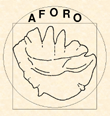




Site best viewed with 1024 x 768 resolution
Publications and presentations
|
Publications:
> A. Lombarte, Ò. Chic, A. Manjabacas, R. Olivella, V. Parisi-Baradad, J. Piera and E. García-Ladona. Six years of the interactive AFORO (otolith shape analysis) database website (2003/2009) 2009. 4th International symposium fish otolith research and application. Monterrey (EE.UU).(PDF). > A. Lombarte, M. Palmer, J. Matallanas, J. Gómez-Zurita and B. Morales-Nin. Ecomorphologic comparisons of otolith sagittae in Nototheniidae. 2009. 4th International symposium fish otolith research and application. Monterrey (EE.UU). (PDF). > J.A. Soria, A. Lombarte, V. Parisi-Baradad. Otolith identification of Merluccius populations and sympatric species with local discriminant bases.2009. 4th International symposium fish otolith research and application. Monterrey (EE.UU). (PDF). > E. Torrecilla, J. Piera, A. Lombarte and V. Parisi-Baradad. Automatic landmark selection of otolith shape contour using the Wavelet Transform Modulus Maxima.2009. 4th International symposium fish otolith research and application. Monterrey (EE.UU). (PDF). > 2008. D. V. Lychakov, Y.T. Rebane, A. Lombarte, M. Demestre, L.A. Fuiman. Saccular otolith mass asymmetry in adult flatfishes. J. Fish. Biol. 72: 2579-2594. (PDF). > 2007. A. Lombarte, A. Cruz. Otolith size trends in marine communities from different depth strata. J. Fish. Biol. 71: 53-76 (SCI: 1.393, citas: 5) (PDF). > Lombarte, A., Ò. Chic, V. Parisi-Baradad, R. Olivella, J. Piera & E. García-Ladona. 2006. A web-based environment from shape analysis of fish otoliths. The AFORO database. Scientia Marina 70: 147-152 (PDF). > Piera, J., V. Parisi-Baradad, E. García-Ladona, A. Lombarte, L. Recasens & J. Cabestany. 2005. Otolith shape feature extraction oriented to automatic classification with open distributed data. Marine and Freshwater Research, 56: 805-814 (PDF). > Parisi-Baradad, V., A. Lombarte, E. García-Ladona, J. Cabestany, J. Piera & Ò. Chic. 2005. Otolith shape contour analysis using affine transformation invariant wavelet transforms and curvature scale space representation. Marine and Freshwater Research, 56: 795-804 (PDF). > Cruz, A. & A. Lombarte. 2004.Otolith size and their relationship with colour pattern and sound production. Journal of Fish Biology, 65: 1512-1525 (PDF). > V. Lychakov, Y.T. Rebane, A. Lombarte, L.A. Fuiman, A. Takabayashi. 2006. Fish otolth aymmetry: morphometry and modeling. Hearing Research 219: 1-11 (PDF). Presentations: 3d International symposium fish otolith research and application: > AFORO: An interactive shape analysis and classification system for fish otoliths (Abstract / Presentation). > Otolith size trends in different depth marine communities (Abstract / Presentation). > Otolith shape feature extraction oriented to artificial neural network classification (Abstract / Presentation). > Otolith shape contour analysis using affine transformation invariant Wavelet Transforms and Curvature Scale Space representation (Abstract / Presentation). Abstracts: Oral Presentation: "AFORO: An interactive shape analysis and classification system for fish
otoliths"
Abstract:
Sagitta otolith shape variability was related with fish environment and
their genetics. Otolith shape provides information of species, their
ecobiological parameters and fish geographic origin. Oral Presentation: "Otolith size trends in different depth marine communities"
Abstract:
660 sagitta otoliths from 132 species belonging to 7 demersal
communities or subcommunities of different depth and bottom structure
and one pelagic community from North Western Mediterranean were
compared in order to study otolith relative size and morpho-functional
trends. In every community was selected the most characteristic
species. Sagitta otoliths were digitised from their medial side (sulcus
acusticus side). The relationship between area of medial side of
otolith sagitta and total length of the fish was calculated to
determine otolith relative size. The otoliths were divided in three
groups (small, medium and large) and was calculated the percentage of
every otolith size group in each community. Oral Presentation: "Otolith shape feature extraction oriented to artificial neural network
classification"
Abstract:
Otolith shape classification is a common procedure in otolith related
studies (morphological, taxonomical, palaeontological and food web
analysis). Oral Presentation: "Otolith shape contour analysis using affine transformation invariant
Wavelet Transforms and Curvature Scale Space representation"
Abstract:
Two decades ago different methods and techniques related to image
analysis began to be used in fish otolith studies (ageing, stock
determination, species identification ...). In this paper we show the
application of two recent signal processing techniques (wavelet
transform and curvature scale space), which complement the information
gathered using Fourier analysis methods. The motivation comes from the
necessity to perform an otolith analysis capable of localizing its
contour singularities, since these are very important points in
automated identification tasks, very close to landmark selection done
by trained human operators. 1.- Institut de Ciències del Mar (CSIC). Passeig Marítim 37-49, 08003 Barcelona, Catalonia, Spain. 2.- Dept. Eng. Electrònica, Universitat Politècnica de Catalunya (UPC), Barcelona, EU. 3.- Dept. Teoria del Senyal i Comunicacions, Universitat Politècnica de Catalunya (UPC), Barcelona, EU. 4.- Dept. de Ciencias de la Computación e Inteligencia Artificial. Univ. del País Vasco, San Sebastian (Spain). |